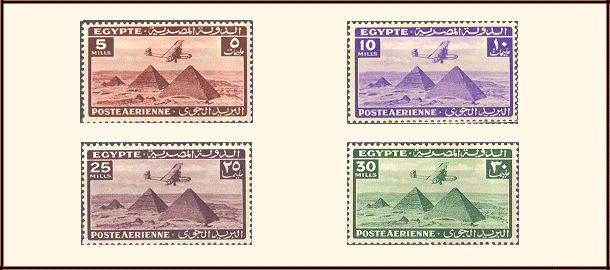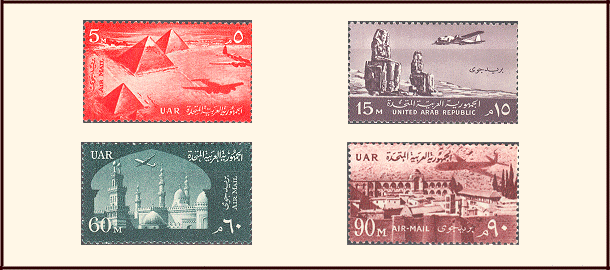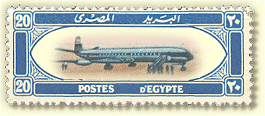
|

|
Egypt has issued stamps specifically for airmail since March 10, 1926: while many of these have been part of commemorative sets, some have been of a definitive nature. Most of them indicate that they are for air mail use, first in French, later in English but always, and sometimes alone in contravention of UPU rules, with the Arabic barid howey (Air Mail). The first stamp was issued specifically for official use on the Cairo to Baghdad air route; if it was used for any other reason the mail was subject to postage due. Violet in colour, at 27 millièmes the stamp covered both the normal surface rate of 15m and the air surcharge of 12m for a letter weighing up to 20gm. The service had started in 1922 and airmail post up to then had used normal postage stamps to the required rate. On July 17, 1929, the colour was changed to brown for no reason that is clear to us.
In April 1931 Egypt was a stop on one of the Graf Zeppelin's flights and the current brown 27m was overprinted with two values, 50m and 100m, the special rates for postcards and letters respectively. Although these are airmail stamps for use on an airmail trip, they are considered to be commemoratives rather than airmail stamps.
In February 1933 one of the best known of Egyptian stamps was issued, illustrating a Handley Page HP42 aircraft over the Pyramids. The set comprised 12 values: 1m to 10m in steps of 1m, and then 10m steps to 100m and a 200m stamp. The issue was brought about by the extensive expansion of airmail routes and the profusion of postage rates to the many and varied destinations. These stamps again were supposedly valid only for letters sent by airmail, but on August 1, 1938, this restriction was ended. In 1938 the colour of the 2m was changed from grey to red-orange.
In 1941 a new single-coloured set in a similar design was issued, with four values now printed by photogravure. The 5m, 10m and 30m values were repeated, with an additional value of 25m. The 30m was overprinted in 1946 for the Middle East International Air Navigation Congress held at Cairo. This, like the Graf Zeppelin overprints, is considered a commemorative stamp.
In 1947 a newly designed set of 12 stamps was issued, with an illustration of King Farouk and a DC3 Dakota flying over the Nile Barrage. This set lasted until after the revolution and overthrow of Farouk and can be found with several types of overprints, including in combinations, up to the bar overprints obliterating the deposed King's face.
Several sets have been issued since the revolution in singles or sets of three to ten, some of which are shown below. Often these airmail issues formed part of larger sets, the lower values of which are ordinary definitives.
|

1933-1938: long set of 20 values, 1m to 10m and then in steps of 10m to 100m and a 200m value. The centres of the higher values had various colours and the 2m frame was changed from grey to red-orange in 1938.
|

The photogravure set with the additional 25m value.
|

King Farouk set issued in February-July 1947 of 12 values from 2m to 200m. This set was subsequently overprinted "King of Egypt and the Sudan, 16 October 1951".
Both sets also have the face of the King obliterated by three horizontal bars after the 1952 revolution.
|

In May 1953 similar 5m and 15m stamps were issued, but without the King's portrait. There had been no 15m in the previous Farouk issue.
|

The 1959 set of four values show a change to English from French on three values but for some reason the 15m has Air Mail only in Arabic and the United Arab Republic is
spelt out in full while the other three show only the initials UAR.
|

A single air stamp showing the Cairo Tower was issued in 1961; and then this set of three in March 1963. |

A further set of three was issued in October 1963.
|

A few single stamps were issued; in 1970 a set of two in memory of President Nasser and then this set of three in August-November 1972.
|

A further set of five values was issued through 1978-1985 comprising the three designs shown. In 1982 the 45m was reissued with a denomination change to 60m and a
colour change to olive-brown and the 145m was changed to 185m in greenish-blue. What marks out this set is that for the first time there is no wording to indicate,
in English or Arabic, that these are air mails, only the silhouette of an aeroplane.
|

